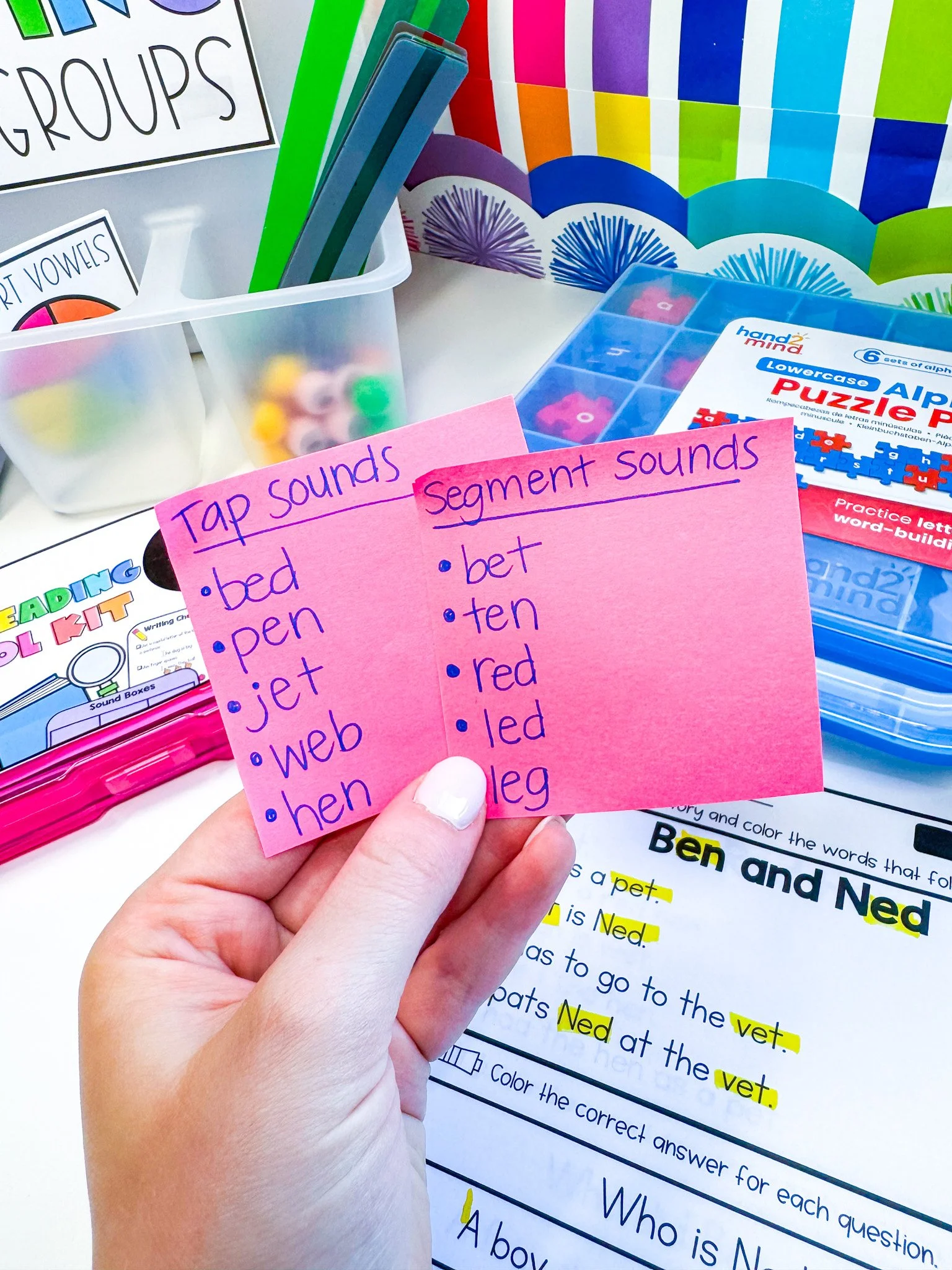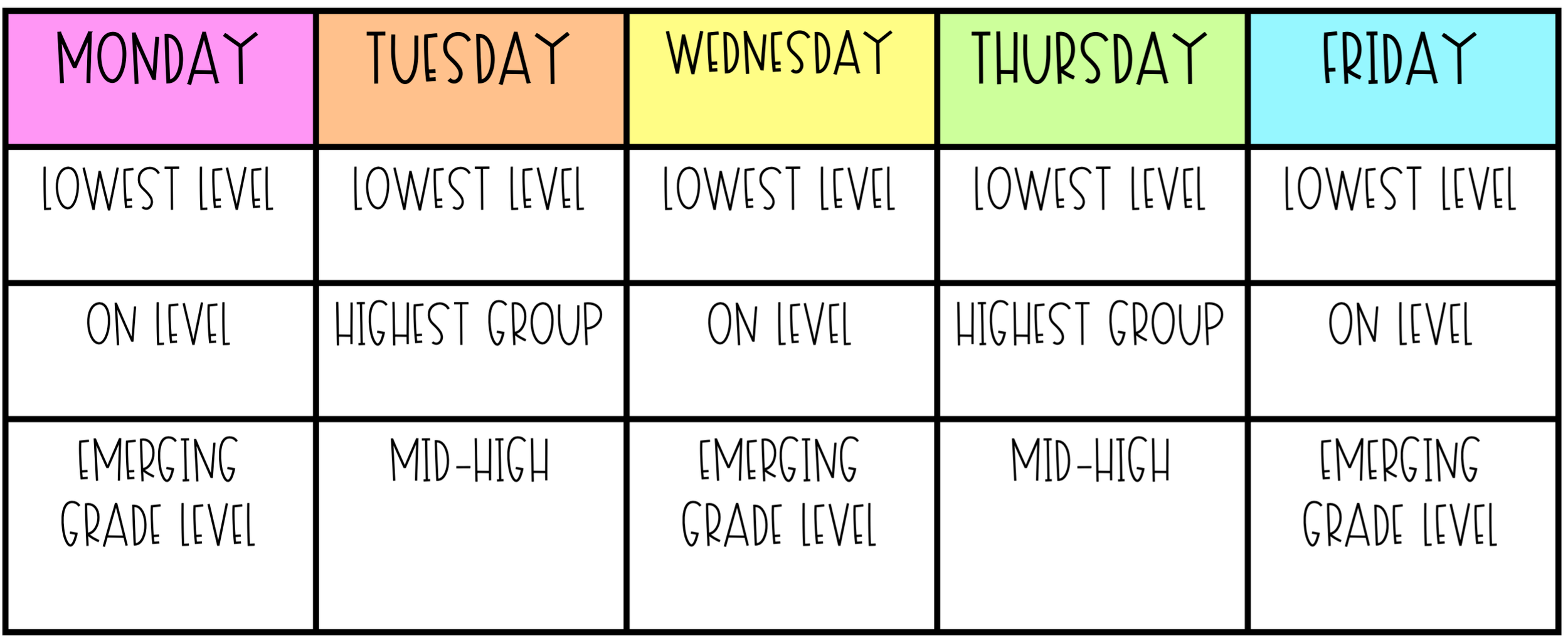Sample Science of Reading Based Small Group Lesson
While I do think that meaningful, explicit whole group literacy instruction (tier one instruction) is the most effective way to reach students, small groups do play a huge role in literacy differentiation as well and are necessary. If you’ve ever been stuck on how to structure a literacy small group lesson, I’ve put together a sample lesson structure for an “on grade level” group below (with differentiated ideas for a lower and higher group as well). This simple structure can be used during all of your small groups (no matter their level) as an easy way to meet students where they are in their literacy journey.
How long is each small group and what is the rest of the class doing during that time?
Each group meets for about 15-20 minutes. While I am meeting with small groups, the rest of the students are working in centers. My blog about all about literacy centers can be found here.
What tools do you use during small groups?
I have a caddy full of fun things to use during small groups. You can see them all here. Know that I don’t use everything during every group every day. I switch these things out throughout the year to keep things new and fresh (while still maintaining the simple structure of the meeting).
Sample Group Meeting Structure:
Step 1: Phonemic Awareness Warm Up (2-3 Mins)
Phonemic awareness is an important skill for students to practice, and it is all done through listening and speaking (no writing utensils are pulled out during this warm up). If you don’t use Heggerty Phonemic Awareness, it is a great place to start to get some ideas on some warm ups to do with your group. We do the entire Heggerty lesson each day as a class, but I take snippets of it and do them as a small group warm up just so I can see how each student’s phonemic awareness is.
Ex: for a mid-level group practicing CVC, we might tap and segment sounds quickly.
Teacher says: bed- students tap b/e/d
Teacher says : b/e/d, students count the sounds and say the word bed (3)
*Lower level group may listen for beginning and ending sounds in words, and practice letter sounds
*Higher level group may work on complex vowel variants (vowel teams, diphthongs, etc.) or multisyllabic words
Step 2: Phonics Word Work (5 minutes)
Phonics word work is important to help students learn to decode and spell. We use different resources during this time (letter tiles, dry erase sound maps, etc) You can find those things in my reading tool kit. I also have an amazing series of word building lessons with print and go letter tiles (students each have a letter strip of tiles that they need for the lesson and they quickly cut them apart) that can be found here.
Ex: for a mid-level group practicing CVC, we build words using letter tiles (or write on sound maps)
Swap beginning or ending sounds (word chaining)- bed>fed>led>let>met>men
*Lower level group may listen for teacher to call a letter sound and they would write the letter (or listen to the initial or ending sound in a word and determine the letter they hear and write it)
*Higher level group may work on building/writing more complex vowel variants (vowel teams, diphthongs, etc.) or multisyllabic words
Step 3: Decodable Reading (7-8 minutes)
This is where students apply those decoding skills by reading a decodable book or passage. You want to focus on decoding, but also on fluency and expression. If you have decodable books that you like to use, then those would work just great! If you don’t have any, I have a series of one page decodable passages with comprehension questions that can be used in small groups (or as independent practice after their small group). There are enough passages for the entire year.
Ex: For a mid-level group students may read the story together or independently out loud while teacher listens in on each student reading, while helping them use their decoding strategies if they get stuck. You could also choral read together to build fluency, and then have them read it again on their own. There are many ways you could do this.
*Lower level group may read the passage together several times
*Higher level group may read a more difficult passage focusing on complex vowel variants (vowel teams, diphthongs, etc.) or multisyllabic words. They can do this independently while teacher listens in, or together.
Step 4: Comprehension (3-4 minutes)
This piece is mainly what the end goal of a reading group is about- did students understand/comprehend what they read or are they just word-calling? My decodable passages contain comprehension questions but you could also insert your own for students to answer orally, or students could come up with their own questions for each other within the group.
ex: For a mid-level group, students can answer questions such as (but not limited to):
Who were the main characters?
What happened first, next, then, last?
Where did the story take place?
What did ____ do in the story and why?
*Lower level group may answer same questions as above
*Higher level group may answer deeper questions such as (but not limited to):
What message or lesson can we learn (or what message did ___ learn)?
How did the characters solve the problem?
What was the main idea of the story?
What was an example of cause and effect in the story?
Step 5: Wrap Up (1-2 minutes)
This can be done super quickly, but you generally want to wrap up your group by making sure your students know what they worked on with you that day. Wrap up can be done in any way you’d like. You can simply state “great job working on CVC short E words today!” or you can involve students by having them share something.
(ex: before you head back to your centers, I want to hear each of you tell one word that follows the short e CVC pattern!)
For higher level readers, you can always have them write an exit sentence or something of that nature. (ex: on your whiteboards, please write one sentence using a word that has the vowel team /ai/ in it!)
How often do I meet with each leveled group?
This varies from district to district and teacher to teacher, so please take this with a grain of salt! The meeting schedule below is what works for my classroom, but changes year to year based on the different levels within my room. Generally I try to see the lowest level group each day because they are in need of the most help. I see my higher groups twice a week since they still need help but not the kind of help that the lowest group needs to get them back up to speed. Below is a sample small group schedule (each group meets for 15-20 mins) and the small groups begin after our daily reading lesson and phonics instruction (we have a 2 hour block for literacy, so one hour is dedicated to small groups and one hour is dedicated to whole group phonics/reading instruction).
I hope this helped you come up with an easy to follow structure for your daily literacy small groups! Please let me know if you ever have any questions, I would love to hear from you!










